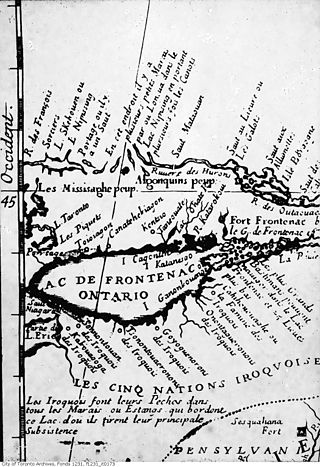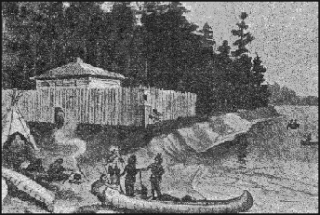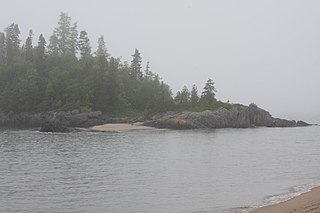
Pierre Gaultier de Varennes, sieur de La Vérendrye was a French Canadian military officer, fur trader, and explorer. In the 1730s, he and his four sons explored the area west of Lake Superior and established trading posts there. They were part of a process that added Western Canada to the original New France territory that was centred along the Saint Lawrence basin.

The Humber River is a river in Southern Ontario, Canada. It is in the Great Lakes Basin, is a tributary of Lake Ontario and is one of two major rivers on either side of the city of Toronto, the other being the Don River to the east. It was designated a Canadian Heritage River on September 24, 1999.

The Toronto Carrying-Place Trail, also known as the Humber Portage and the Toronto Passage, was a major portage route in Ontario, Canada, linking Lake Ontario with Lake Simcoe and the northern Great Lakes. The name comes from the Mohawk term toron-ten, meaning "the place where the trees grow over the water", an important landmark on Lake Simcoe through which the trail passed.

Fort William was a city in Ontario, Canada, located on the Kaministiquia River, at its entrance to Lake Superior. It amalgamated with Port Arthur and the townships of Neebing and McIntyre to form the city of Thunder Bay in January 1970. Since then, it has been the largest city in Northwestern Ontario. The city's Latin motto was A posse ad esse, featured on its coat of arms designed in 1900 by town officials, "On one side of the shield stands an Indian dressed in the paint and feathers of the early days; on the other side is a French voyageur; the cent[re] contains a grain elevator, a steamship and a locomotive, while the beaver surmounts the whole."

The Toronto waterfront is the lakeshore of Lake Ontario in the city of Toronto, Ontario, Canada. It spans 46 kilometres between the mouth of Etobicoke Creek in the west and the Rouge River in the east.

York Factory was a settlement and Hudson's Bay Company (HBC) factory on the southwestern shore of Hudson Bay in northeastern Manitoba, Canada, at the mouth of the Hayes River, approximately 200 kilometres (120 mi) south-southeast of Churchill.

Teiaiagon was an Iroquoian village on the east bank of the Humber River in what is now the York district of Toronto, Ontario, Canada. It was located along the Toronto Carrying-Place Trail. The site is near the current intersection of Jane Street and Annette Street, at which is situated the community of Baby Point.

Jacques-René de Brisay, Marquis de Denonville was the Governor General of New France from 1685 to 1689 and was an important figure during the intermittent conflict between New France and the Iroquois known as the Beaver Wars.

Fort Rouillé was a French trading post located in what is now Toronto, Ontario, Canada. Fort Rouillé was constructed by the French in 1751, building upon the success of a trading post they established in the area a year earlier, known as Fort Toronto. Fort Rouillé was named for Antoine Louis Rouillé, who at the time of its establishment was Secretary of State for the Navy in the administration of King Louis XV of France. It served as a trading post with the local indigenous peoples from the region.

Sunnyside is a lakefront district in Toronto, Ontario, Canada. It includes a beach and park area along Lake Ontario's Humber Bay, from west of Exhibition Place to the mouth of the Humber River. The area has several recreation uses, including rowing clubs, sports clubs, picnic areas, playgrounds, a nightclub, a bathing pavilion and public pool. The area is a 3 kilometres (1.9 mi) long strip along the lakeshore, bounded by the Gardiner Expressway and rail lines, which separate it from the Parkdale, Roncesvalles and Swansea neighbourhoods to the north. The name originates in a local farm owned by John Howard, which was situated just to the north, on the location of the current St. Joseph's Health Centre hospital.

Fort Kaministiquia, was a French fort in North America. It was located on the north shore of Lake Superior at the mouth of the Kaministiquia River, in modern-day Thunder Bay, Ontario, Canada. It and Grand Portage to the west were the starting points of the early Canadian canoe routes from the Great Lakes to western Canada. Details of the route can be found under Kaministiquia River.

Humber Bay is a bay of Lake Ontario south of Toronto, Ontario, Canada. It is located between Ontario Place on the east and Mimico Creek to the west. The bay gives its name to Etobicoke's Humber Bay neighbourhood.

Old Mill is a neighbourhood of Toronto, Ontario, Canada on the banks of the Humber River. It is located north and west of the intersection of Bloor Street and Jane Street. The area takes its name from the old grist mill ruins on the west bank of the river, now converted into a hotel. The City of Toronto includes this neighbourhood in the official "Lambton Baby Point" neighbourhood which includes the Baby Point enclave and former Lambton village areas to the north.

Magasin royal was the generic name given to a trading post under the purview of the King of France. The name also applied specifically to two trading posts that were built during the 18th century for French fur trading near the Humber River in the Pays d'en Haut region of New France, in present-day Toronto, Ontario, Canada. According to Ron Brown, author of From Queenston to Kingston: The Hidden Heritage of Lake Ontario's Shoreline, the fort was "little more than a log cabin", and archeologists considered it "the first non-aboriginal building in the Toronto area".

The Pays d'en Haut was a territory of New France covering the regions of North America located west of Montreal. The vast territory included most of the Great Lakes region, expanding west and south over time into the North American continent as the French had explored. The Pays d'en Haut was established in 1610 and depended on the colony of Canada until 1763, when the Treaty of Paris ended New France, and both were ceded to the British as the Province of Quebec.
Pierre Robineau de Portneuf, was an officer in the colonial regular troops. He was born on August 9, 1708, in Montreal, Quebec, second son of René Robineau de Portneuf and Marguerite Daneau de Muy, He married Marie-Louise Dandonneau Du Sablé on April 22, 1748. He died November 15, 1761, in the shipwreck of the Auguste off Cape Breton Island.

Bead Hill is an archaeological site comprising the only known remaining and intact 17th-century Seneca site in Canada. It is located on the banks of the Rouge River in Rouge Park, a national park in Toronto, Ontario. Because of its sensitive archaeological nature, it is not open to the public, nor readily identified in the park. It was designated a National Historic Site in 1991, eventually becoming a unit of the national park system in June 2019.
Jean-Bonaventure Rousseau was an influential fur trader in New France, and, after its capture by Great Britain, the Province of Canada. His father who also went by the given name Jean, had been a fur trader in the Ohio River valley. His son Jean Baptiste Rousseau started as a fur trader before becoming one of the most important merchants in Upper Canada.

Michipicoten Provincial Park is a park in Ontario, Canada, located at the mouth of the Michipicoten River. The park preserves the ruins of a French trading post that operated from the early 1700s until it was abandoned by the Hudson’s Bay Company in 1904.
















